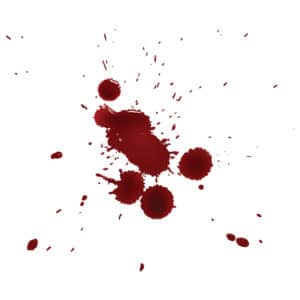This type of evidence is often used to convict — but may not be scientifically accurate.
Joe Bryan, a former high school teacher from Texas, is currently serving a 99 year prison sentence for the 1985 murder of his wife, Mickey. According to a two-part series published by the New York Times Magazine and ProPublica, he was convicted on the basis of specks of what may have been blood that were found on a flashlight in the trunk of his car. There was no other physical evidence that tied him to the crime, and no motive was introduced for the murder. The flashlight may have been planted in his car. Bryan was convicted on the testimony of Detective Robert Thorman, who testified as an expert in bloodstain pattern analysis. Detective Thorman was certified as an expert in the field after taking a weeklong course in the subject. Based on an investigation into Bryan’s case, the Texas Forensic Science Commission decided to create an accreditation requirement for bloodstain pattern analysis experts in Texas.
Fans of television crime shows may believe that bloodstain pattern analysis is a highly scientific process. In reality, there is often little science behind analyzing blood left at a crime scene — particularly when done by an “expert” that has received very little training. In 2009, the National Academy of Sciences found that “…the opinions of bloodstain pattern analysts are more subjective than scientific,” and “the uncertainties associated with bloodstain pattern analysis are enormous.” The report found that those interpreting blood patterns in court proceedings should have, at minimum, an understanding of applied mathematics, the physics of fluid transfer and the pathology of wounds. However, in many cases, the experts testifying about bloodstain pattern analysis are police officers or detectives who took a weeklong course.
California led the country in accepting bloodstain pattern analysis as an acceptable form of evidence in criminal cases. According to a murder defense lawyer Los Angeles, CA, in 1957, the Supreme Court of California affirmed that bloodstain pattern analysis is a proper area for expert testimony. The Court qualified Paul Leland Kirk, a scientist and criminalist, as a qualified expert in the field.
Bryan’s case may be based in Texas, but the use of bloodstain pattern analysis is a nationwide issue. Bloodstain pattern analysis has been used in courtrooms across the country to convict defendants of crimes, typically murder. According to the 2009 National Academy of Sciences study, one of the major shortcoming of bloodstain pattern analysis is that there are no known rates of error for this “science.” To obtain error rates, experts would have to conduct scientific testing and peer review of studies of bloodstains. In contrast to other forms of forensic science, such as DNA, this has not been done — making bloodstain pattern analysis much more prone to error and bias.
As a murder defense lawyer Los Angeles, CA can explain, the unreliability of bloodstain pattern analysis is incredibly important when it comes to defending against serious California criminal charges. A skilled attorney can and should challenge the introduce of this type of “expert” testimony, particularly when it may be the only evidence linking a suspect to a crime.
At the Chambers Law Firm, our team of highly experienced professionals is committed to providing the best possible defense to our clients. This includes staying on top of important advances in forensic science, such as the recommendations from the National Academy of Science. If you have been charged with a crime, we can help. Contact us today at 714-760-4088 or dchambers@clfca.com to schedule a free initial consultation with a murder defense lawyer Los Angeles, CA.





